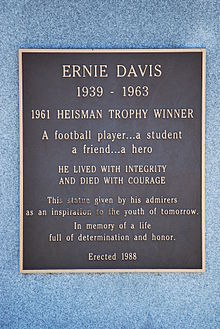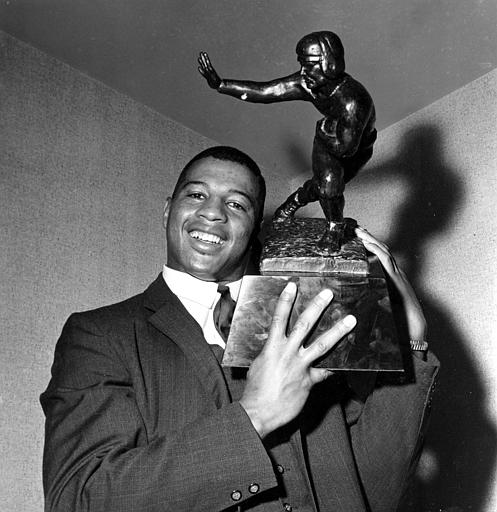
The first African-American Heisman Trophy Winner: Ernie Davis
Ernest “Ernie” Davis (December 14, 1939 – May 18, 1963) was an American football halfback and the first African-American athlete to win the Heisman Trophy. Wearing number 44, Davis played college football for Syracuse University before being drafted by the Washington Redskins, then almost immediately traded to the Cleveland Browns in December 1961, when he was issued number 45. However, he never played a professional game, as he was diagnosed with leukemia in 1962 and died at the age of 23 years.
Davis found discrimination prevalent during his Cotton Bowl visit to in host city Dallas, Texas. Author Jocelyn Selim writes that at the banquet following the 1960 game, Davis was told he could only accept his MVP award for the game and then would be required to leave the segregated facility. According to an article in the Houston Chronicle, all the players from the game attended the banquet. Brown recalls that the teams sat on opposite sides of the room. After everyone ate and the trophies were handed out, the three black Syracuse players, including Brown and Davis were asked to leave and were taken to another party in Dallas by local NAACP representatives. One Syracuse player, Gerhard Schwedes, recommended that the whole Syracuse team leave the banquet to show solidarity with their black teammates, but the suggestion was overruled by Syracuse officials.
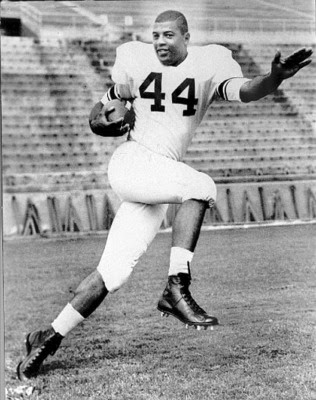
Davis became the first black athlete to be awarded the Heisman Trophy (the highest individual honor in collegiate football) and he also won the Walter Camp Memorial Trophy following his 1961 senior-year season at Syracuse University. President John F. Kennedy had followed Davis’ career and requested to meet him while he was in New York to receive the trophy. Later in 1963, when Elmira, NY (where Davis grew up) chose February 3 to celebrate Davis’ achievements, Kennedy sent a telegram, reading:
| “ | Seldom has an athlete been more deserving of such a tribute. Your high standards of performance on the field and off the field, reflect the finest qualities of competition, sportsmanship and citizenship. The nation has bestowed upon you its highest awards for your athletic achievements. It’s a privilege for me to address you tonight as an outstanding American, and as a worthy example of our youth. I salute you. | ” |
During his time at Syracuse, Davis wore the same number, 44, as legendary Orangeman Jim Brown, helping to establish a tradition at the school that was acknowledged on November 12, 2005, when the school retired the number in an on-field ceremony. After winning the Heisman Trophy, Ernie Davis talked Floyd Little into doing an about face and play football for Syracuse instead of Notre Dame. Davis also played basketball at Syracuse for one season 1960-1961. Syracuse University, as a way to honor all of the athletes that have worn the number 44, was granted permission by the United States Postal Service to change its zip code to 13244.
While attending Syracuse, Davis was a member of the Sigma Alpha Mu Fraternity, a nationally recognized Jewish fraternity. Davis was the first African-American to become part of the organization not only at the Syracuse chapter, but for the national fraternity as a whole.
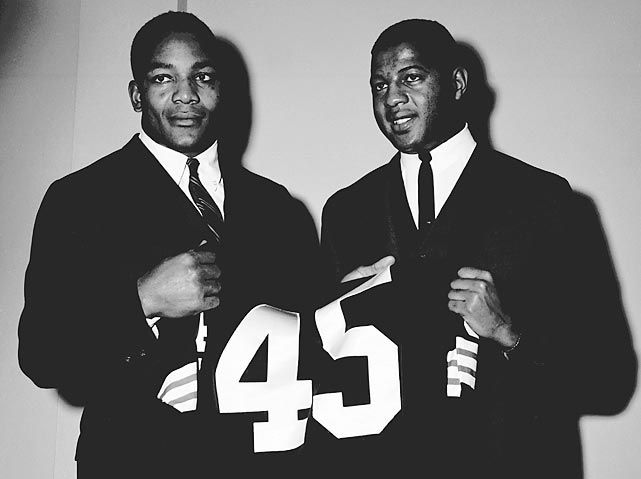
Davis was the number-one pick in the 1962 NFL Draft. Selected by the Washington Redskins, he was traded to the Cleveland Browns. He was also drafted by the Buffalo Bills of the American Football League.
Redskins founder and owner George Preston Marshall was an open and unashamed racist, and kept the Redskins white long after the other teams had integrated. He openly admitted that his unwillingness to sign a black player was an effort to appeal to his mostly Southern fan base (they had long been the southernmost team in the league). The signing only came when Interior Secretary Stewart Udall issued an ultimatum to Marshall: sign a black player by the start of the 1962 season, or he would revoke the Redskins’ 30-year lease on D.C. Stadium (now Robert F. Kennedy Memorial Stadium). The stadium was a city-owned facility, and the Washington city government has long been legally reckoned as a branch of the federal government (given that the Constitution gives Congress ultimate authority over the capital). Marshall could not bring himself to draft a black player, so he left the decision to general manager and head coach Bill McPeak, who picked Davis. Davis refused to play for the Redskins, and demanded a trade. In turn a trade to Cleveland was engineered by Browns coach Paul Brown, without the knowledge and consent of the team’s new owner, Art Modell. This had been standard operating procedure with the Browns from their inception in 1946; Brown served as his own general manager, and had enjoyed more or less a free hand in football matters. Davis chose to go to the Cleveland Browns where his classmate John Brown would be his roommate and Jim Brown, whom he admired, was already playing.
Davis signed a three-year, $200,000 contract with the Browns in late December 1961, again without the knowledge or consent of Modell, while he (Davis) was in San Francisco, California practicing for the East-West Shrine Game. Originally reported at $80,000, the contract, according to Davis’ attorney, A. William (Tony) DeFilippo, consisted of $80,000 for playing football, including a $15,000 signing bonus; $60,000 for ancillary rights, such as image marketing; and $60,000 for off-season employment. It was the most lucrative contract for an NFL rookie up to that time. However, the Browns’ dream of pairing Davis with Jim Brown in the backfield took a tragic turn when Davis was diagnosed with acute monocytic leukemia during preparations for the 1962 American Football Coaches All-American Game in Buffalo, New York and also at Browns training camp. The rift between Coach Brown and Modell worsened when Modell brought in doctors who said Davis was well enough to play. However, Brown refused to suit him up. Although Davis’ leukemia was in remission at the time, Brown felt letting him play would hurt team morale. This contributed to Modell’s decision to replace Brown before the 1963 season.
Davis was allowed to practice on the field (without physical contact) and helped Brown draw up game plans, but never played a meaningful down. His only appearance at Cleveland Stadium came during a 1962 pre-season game, in which he ran onto the field as a spotlight followed him.
Unfortunately, the disease was incurable and he died in Cleveland Lakeside Hospital May 19, 1963, at the age of 23.Following his death, the Browns retired his number 45 jersey.
Davis was posthumously inducted into the College Football Hall of Fame in 1979.
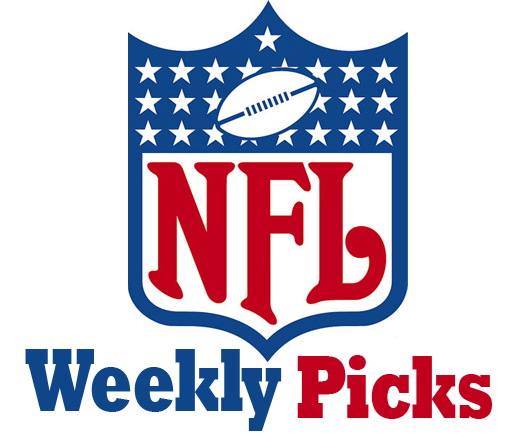
MIN @ ARI |
BUF @ PHI |
SF @ CLE |
DET @ STL |
NO @ TB |
TEN @ NYJ |
PIT @ CIN |
IND @ JAC |
SD @ KC |
WAS @ CHI |
ATL @ CAR |
SEA @ BAL |
OAK @ DEN |
DAL @ GB |
NE @ HOU |
NYG @ MIA |
||
Tunisia |
ARI |
BUF |
SF |
DET |
NO |
TEN |
PIT |
JAC |
KC |
WAS |
CAR |
SEA |
OAK |
GB |
NE |
NYG |
|
AdKomack |
ARI |
PHI |
CLE |
TB |
NYJ |
PIT |
JAC |
KC |
CHI |
CAR |
SEA |
OAK |
GB |
NE |
MIA |
||
MsKitty |
ARI |
BUF |
SF |
STL |
TB |
NYJ |
CIN |
JAC |
KC |
CHI |
CAR |
SEA |
OAK |
GB |
NE |
MIA |
|
Kmack |
ARI |
BUF |
SF |
DET |
TB |
NYJ |
CIN |
IND |
KC |
WAS |
CAR |
SEA |
DEN |
GB |
NE |
MIA |
|
GreenLady |
ARI |
BUF |
SF |
DET |
TB |
NYJ |
CIN |
IND |
KC |
CHI |
CAR |
SEA |
DEN |
GB |
NE |
NYG |
|
Sagittarius |
PHI |
CLE |
DET |
TB |
NYJ |
PIT |
IND |
KC |
CHI |
CAR |
SEA |
DEN |
GB |
NE |
NYG |
||
TyrenM |
ARI |
PHI |
CLE |
DET |
TB |
NYJ |
CIN |
JAC |
KC |
CHI |
CAR |
SEA |
DEN |
GB |
NE |
NYG |
|
BluMilw |
ARI |
BUF |
SF |
STL |
TB |
NYJ |
PIT |
IND |
KC |
CHI |
CAR |
SEA |
DEN |
GB |
NE |
NYG |
|
Miranda |
MIN |
BUF |
CLE |
DET |
TB |
NYJ |
PIT |
JAC |
KC |
WAS |
CAR |
SEA |
OAK |
GB |
NE |
MIA |


